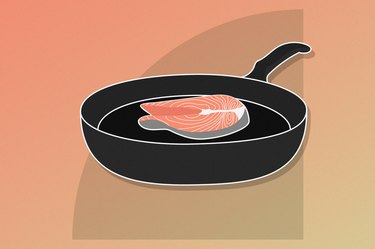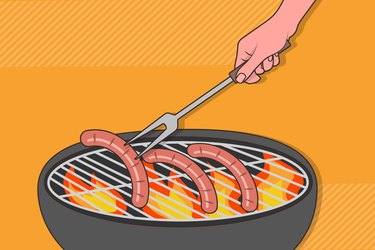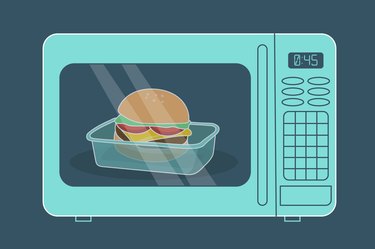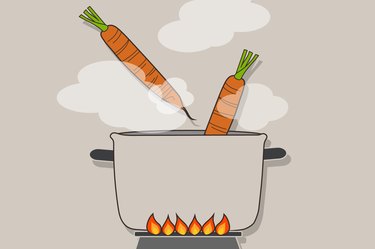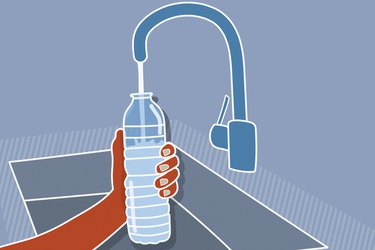
Your frying pan is likely one of your most-used kitchen tools. Non-stick pans are especially convenient because they have a coating that makes them easier to use and clean. But while they're easier, there's some debate as to whether or not non-stick cookware is really safe.
Here, we take a deep dive into what the existing research has to say on the safety of non-stick cookware.
Video of the Day
Video of the Day
Non-stick cookware makes it easy to cook foods like eggs and hash browns with less butter or oil. But, there’s some controversy surrounding the potential health risks of chemicals used to make non-stick pans.
At high temperatures, non-stick coatings break down and can release harmful chemicals, but there’s a lot we still don’t know about how these chemicals affect us. The long-term effects of these chemicals accumulating in the human body aren’t well understood.
When used as directed and at lower temperatures, non-stick cookware is relatively safe to use, though alternatives also exist.
What Is Non-Stick Cookware?
Non-stick cookware includes pots and pans that are coated with synthetic compounds designed to make the cookware easier to use and clean. This can include saucepans, dutch ovens, utensils and other types of cooking equipment, but it's mostly associated with frying pans and shallow skillets.
The most commonly used compound to make non-stick coatings is polytetrafluoroethylene (PTFE), according to an October 2017 review in Environmental Science and Pollution Research International. It's most commonly referred to as Teflon — a brand name of the material.
Teflon is popular in cookware because it is resistant to heat and acts as a water repellant, so it can get very hot but allows liquid ingredients to move around so they don't adhere to the pan. It's also found in some textiles.
Other cookware materials of concern include perfluorooctanoic acid (PFOA) and perfluorooctane sulfonate (PFOS). These chemicals have been used for decades not only in cookware but in other household products like carpets and paper goods. They are highly resistant to heat, sticking and scratching.
Non-stick material is only used for the coating on the outer surface of the cookware. The core may still be made of other materials, such as stainless steel, aluminum, ceramic or other materials.
Because chemicals like PTFE, PFOA and PFOS aren't as understood, ceramic non-stick coatings are becoming more common.
Potential Risks of Non-Stick Cookware
There are talks that non-stick pans and cookware made with chemicals like PTFE, PFOA and PFOS may raise the risk of certain diseases or have other negative health consequences.
The idea is that the non-stick coating breaks down and flakes off over time, allowing small pieces to get into the food that you eat, so the chemicals enter your body and cause harm.
Potential PTFE Risks
Aware of the concerns surrounding PTFE, the leading maker of non-stick coatings, Teflon, suggest that Teflon non-stick coatings are safe to use up to 500 degrees Fahrenheit and contribute to a heart-healthy lifestyle because they lower the need for oil and fat, per the Teflon website. But this may be biased, so let's take a look at the existing research.
Some studies show PTFE-coated cookware can release gasses and chemicals that are mildly to severely toxic to people, according to the October 2017 Environmental Science and Pollution Research International review. But the researchers say more studies are needed for firm conclusions on the long-term effects.
Non-stick coatings made with PTFE may leach microplastics into food during the cooking process. Microplastics are very small pieces of plastic debris that enter our bodies through the degradation of plastics in our environment, and while we don't yet fully understand their effects on our health, they're a growing concern, according to a May 2021 article in Nature.
Thousands to millions of microplastics may be released during cooking with PTFE-coated cookware, according to December 2022 research in The Science of the Total Environment.
Potential PFOA and PFOS Risks
There are similar concerns for PFOA and PFOS coatings. Because it doesn't break down easily, PFOA exposure is very common in humans, but the health effects are largely unknown, according to the CDC.
Some animal and human studies have linked these chemicals to a higher risk for various cancers, such as testicular and breast cancers, according to the American Cancer Society. Other studies have not found a link, however, so more research is needed on how they affect people.
What we do know is that agencies like the Environmental Protection Agency (EPA) have introduced measures to lower our exposure to PFOA and PFOS because they can accumulate in the human body over long periods of time. For this reason, many non-stick coatings no longer use PFOA and PFOS.
So, Is Non-Stick Cookware Safe?
To answer the question of whether or not non-stick pans are toxic, the short answer (as of now) is that we don't really know the long-term effects of using them, but they're considered safe when used correctly.
The safest way to use non-stick cookware is to follow the cooking and care instructions provided by the manufacturer. Typically, that means cooking at temperatures below 500 F. There is more of a potential risk when cooking at higher temperatures, so cooking on low and medium heat can help keep the risks low.
Cooking at lower temperatures may not eliminate all the risks, but the long-term effects of non-stick coatings are still not well-understood, and more research is needed to fully assess the safety concerns.
Today, PFOA and PFOS are less common in cookware made in the United States. However, they may still be present in cookware manufactured in other countries. PTFE is still used in U.S.-made products.
Alternatives to Non-Stick Cookware
Non-stick cookware made with PTFE and other chemicals is relatively cheap and easy to find, use and clean. There are a lot of pros to using non-stick pans, but the lack of research on the long-term effects has many feeling weary.
Luckily, there are other alternatives to non-stick pans and cookware you can feel safe using. Check out cookware made from other types of metal and natural materials from this list:
- Aluminum is commonly used in professional kitchens because it conducts heat well. But it reacts with acidic ingredients and warps easily. Chemical reactions with certain foods can cause metals to leach.
- Carbon steel is growing in popularity because it's lightweight, durable, affordable and compatible with most heat sources. The downside is that it requires more care and work to prevent food from sticking.
- Cast-iron pans are long-lasting and affordable. You'll have to keep them properly seasoned for the non-stick benefits, and caring for them can be tricky. While they're great at reaching high temperatures, they can do so unevenly.
- Ceramic cookware can come at a higher price, but it's great for those wanting a non-stick option made from more natural materials. Though ceramic won't leach into food, it may not heat quickly and evenly.
- Copper pans look beautiful and allow for even cooking. However, they're pricey and high-maintenance. If not cared for correctly, copper can leach into food.
- Stainless steel is a popular choice among professional chefs because it's super durable and resists scratching. The downside is that the metal may leach into food. It can also be difficult to prevent food from sticking.
- Teflon: "Teflon Nonstick Coatings Myths and Facts"
- Environmental Working Group: "Ptfe (Teflon)"
- The Science of the Total Environment: “Raman imaging for the identification of Teflon microplastics and nanoplastics released from non-stick cookware”
- American Cancer Society: "Perfluorooctanoic Acid (PFOA), Perfluorooctane Sulfonate (PFOS), and Related Chemicals"
- United States Environmental Protection Agency: "Risk Management for Per- and Polyfluoroalkyl Substances (PFAS) under TSCA"
- CDC: "Perfluorooctanoic Acid (PFOA) Factsheet"
- Nature: Microplastics are everywhere, but are they harmful?

